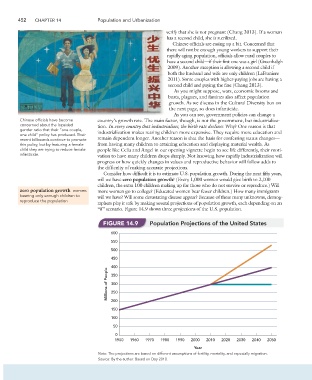Page 479 - Essencials of Sociology
P. 479
452 CHAPTER 14 Population and Urbanization
verify that she is not pregnant (Chang 2013). If a woman
has a second child, she is sterilized.
Chinese officials are easing up a bit. Concerned that
there will not be enough young workers to support their
rapidly aging population, officials allow rural couples to
have a second child—if their first one was a girl (Greenhalgh
2009). Another exception is allowing a second child if
both the husband and wife are only children (LaFraniere
2011). Some couples with higher-paying jobs are having a
second child and paying the fine (Chang 2013).
As you might suppose, wars, economic booms and
busts, plagues, and famines also affect population
growth. As we discuss in the Cultural Diversity box on
the next page, so does infanticide.
As you can see, government policies can change a
Chinese officials have become country’s growth rate. The main factor, though, is not the government, but industrializa-
concerned about the lopsided tion. In every country that industrializes, the birth rate declines. Why? One reason is that
gender ratio that their “one couple, industrialization makes rearing children more expensive. They require more education and
one child” policy has produced. Their
recent billboards continue to promote remain dependent longer. Another reason is that the basis for conferring status changes—
this policy, but by featuring a female from having many children to attaining education and displaying material wealth. As
child they are trying to reduce female people like Celia and Angel in our opening vignette begin to see life differently, their moti-
infanticide. vation to have many children drops sharply. Not knowing how rapidly industrialization will
progress or how quickly changes in values and reproductive behavior will follow adds to
the difficulty of making accurate projections.
Consider how difficult it is to estimate U.S. population growth. During the next fifty years,
will we have zero population growth? (Every 1,000 women would give birth to 2,100
children, the extra 100 children making up for those who do not survive or reproduce.) Will
zero population growth women more women go to college? (Educated women bear fewer children.) How many immigrants
bearing only enough children to will we have? Will some devastating disease appear? Because of these many unknowns, demog-
reproduce the population
raphers play it safe by making several projections of population growth, each depending on an
“if” scenario. Figure 14.9 shows three projections of the U.S. population.
FIGURE 14.9 Population Projections of the United States
600
550
500
450
400
Millions of People 350
300
250
200
150
100
50
0
1950 1960 1970 1980 1990 2000 2010 2020 2030 2040 2050
Year
Note: The projections are based on different assumptions of fertility, mortality, and especially migration.
Source: By the author. Based on Day 2010.

